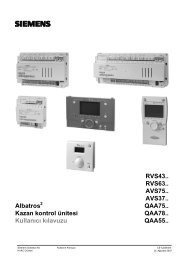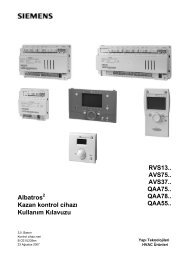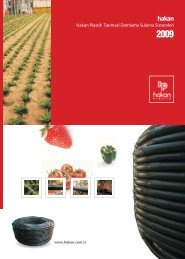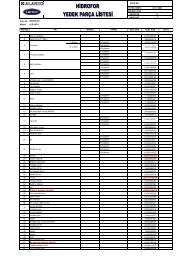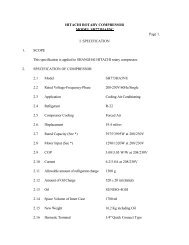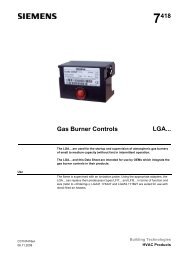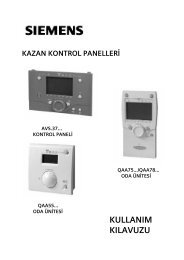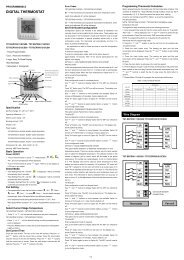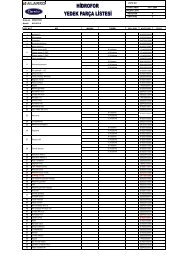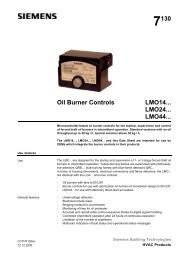Glandless Pumps - THERMO-ECO-ENGINEERING úvod
Glandless Pumps - THERMO-ECO-ENGINEERING úvod
Glandless Pumps - THERMO-ECO-ENGINEERING úvod
Create successful ePaper yourself
Turn your PDF publications into a flip-book with our unique Google optimized e-Paper software.
Planning Guide<br />
High-Efficiency <strong>Pumps</strong><br />
Wilo-Stratos <strong>ECO</strong>/<strong>ECO</strong>-BMS/<strong>ECO</strong>-Z/<strong>ECO</strong>-Z-BMS/<strong>ECO</strong>-ST<br />
Wilo-Stratos <strong>ECO</strong>, Stratos <strong>ECO</strong>-BMS, Stratos <strong>ECO</strong>-Z,<br />
Stratos <strong>ECO</strong>-Z-BMS, Stratos <strong>ECO</strong>-ST<br />
The Wilo-Stratos <strong>ECO</strong> series with the variants Stratos <strong>ECO</strong>-BMS,<br />
<strong>ECO</strong>-Z, <strong>ECO</strong>-Z-BMS and <strong>ECO</strong>-ST supplement the previously<br />
described Wilo-Stratos series with the following advantages:<br />
- energy savings of up to 80% compared with standard pumps<br />
- Stratos <strong>ECO</strong>, <strong>ECO</strong>-BMS, <strong>ECO</strong>-Z and <strong>ECO</strong>-Z-BMS version for all heating<br />
systems in the temperature range +15 °C to +110 °C<br />
- Stratos <strong>ECO</strong>-ST version for solar thermal systems in the temperature<br />
range +15°C to +110°C<br />
- automatic adjustment of pump performance to continually changing<br />
hydraulic system load conditions<br />
- preventing flow noise<br />
- reliability and comfort during installation and operation<br />
Fields Of application<br />
The Wilo-Stratos <strong>ECO</strong>, <strong>ECO</strong>-BMS, <strong>ECO</strong>-Z, <strong>ECO</strong>-Z-BMS and <strong>ECO</strong>-ST<br />
series can be utilised as high-efficiency pumps in circulation systems<br />
for heating and in solar heating systems in 1-6-family houses.<br />
Temperature range<br />
Fluid temperature range of +15 °C to +110 °C at ambient temperatures<br />
of 0 °C to a max. of + 40 °C.<br />
Heating application<br />
On account of its corrosion-resistant red bronze pump housing, the<br />
Wilo-Stratos <strong>ECO</strong> in its RG version are particularly suitable for systems<br />
subject to the possible ingress of oxygen, e.g. floor heaters with<br />
heating surfaces composed of plastic piping.<br />
Heat insulation with heating applications<br />
In order to prevent thermal losses through the pump housing, Wilo-<br />
Stratos <strong>ECO</strong> series single-head pumps (except Stratos <strong>ECO</strong>-ST) are<br />
standard-equipped with thermal insulation shells.The EPP material<br />
used (foamed polypropylene), has the following properties:<br />
- Environmental compatibility: easily recyclable<br />
- Heat resistance: up to 120 °C<br />
- Transmission coefficient: 0.04 W/mK in accordance with DIN 52612<br />
- Flammability: Class B2 in accordance with DIN 4102 (normal flammability)<br />
In Germany, normally flammable materials can, in accordance with<br />
fire protection regulations, be used in boiler rooms as long as a minimum<br />
distance of 20 cm from the burner is maintained.<br />
Utilisation of potable water circulation<br />
(Wilo-Stratos <strong>ECO</strong>-Z, <strong>ECO</strong>-Z-BMS)<br />
<strong>Pumps</strong> used in potable water circulation systems are subject to specific<br />
requirements which are satisfied by the Wilo-Stratos <strong>ECO</strong>-Z and<br />
<strong>ECO</strong>-Z-BMS Series:<br />
- The fluids involved are potable water and water for food businesses<br />
in accordance with the TrinkwV 2001 (German Potable Water Ordinance).<br />
The design of the pumps take into account calcification in<br />
such a way as to permit an overall carbonate hardness of 20°d at a<br />
max. fluid temperature of +65 °C.<br />
- All plastic parts that come into contact with the pumped liquid are in<br />
conformance with KTW recommendations.<br />
- The differential-pressure control mode p-v allows automatic<br />
adjustment of pump performance in variable volumetric-flow potable<br />
water circulation systems with thermostatically controlled line<br />
shutoff valves.<br />
Automatic air venting<br />
Air venting from the rotor space is effected automatically by the filter<br />
and flow channel system. As the pumping medium flows into the<br />
rotor space, a filter plug in the shaft and a filter disc in the bearing<br />
plate prevent the ingress of the smallest abrasive particles.<br />
The seal between impeller and bearing plate prevents dirt from accumulating<br />
in the A-bearing gap on the motor side.<br />
Advantage: The automatic venting of the rotor space is accelerated,<br />
thus reducing the times of dry-running and of air venting<br />
noise.<br />
Advantage: Damage to the radial bearing or to the can is avoided<br />
through this filtering-out process.<br />
Motor protection<br />
The standard series integrated protection device reliably protects the<br />
pump, in all settings, against overtemperature, excess current draw<br />
and rotor locking.<br />
Advantage: No external motor protection switch is required.<br />
The instructions for electrical power connections published<br />
by the local power supply companies are to be<br />
taken into account.<br />
If a motor protection switch is present in the electrical<br />
installation in cases of replacements and can not be<br />
bypassed, for example, then it is to be set to the max.<br />
current allowed by the specifications listed on the<br />
nameplate.<br />
Manual operation<br />
Control button<br />
All versions of the Wilo-Stratos <strong>ECO</strong> series are operated using the<br />
proven red-button technology (1-button operation). The important<br />
basic functions can thus be safely and comfortably set and adjusted.<br />
Control mode p-v<br />
In the p-v control mode, the differential pressure setpoint is raised<br />
linearly above the permissible volume flow range by between ½Hs<br />
and Hs. The differential pressure generated by the pump is regulated<br />
to the respective differential pressure setpoint.<br />
Fig.:<br />
H max<br />
1 /2<br />
H<br />
Hs<br />
Hs<br />
H min<br />
Control mode p-v<br />
Q<br />
Heating, Air-conditioning,<br />
Cooling<br />
Potable water circulation<br />
Solar thermal<br />
Service/Accessories, Systems<br />
Switchgears and Control<br />
Devices Pump Management<br />
Systems<br />
Wilo Catalogue A1 - Circulating pumps in glandless design<br />
29



